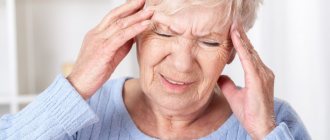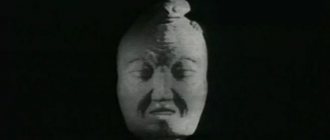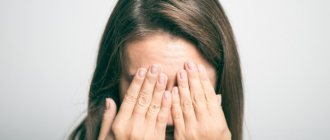General information
With photophobia, a person feels comfortable only in a dark room.
Most people enjoy sunlight and lead an active lifestyle during the daytime, while there are also individuals who are afraid of any lighting and remain “in the shadows.” Such fear can manifest itself both at the somatic and psychological levels. A person can suffer physically, not just emotionally. Normalization of well-being is established when being in a dark room or place.
There are two variants of fear of light.
- Photophobia is the fear of any type of lighting. A person begins to blink reflexively, especially in bright light. He wishes to return to the darkness, closes his eyes.
- Heliophobia is a mental disorder in which there is a fear of sunlight, as well as artificial bright lighting. Heliophobia should not be confused with Gunther's disease. The first is of a psychological nature, while the second is a mutation and causes direct harm to the body when exposed to light.
A person who is afraid of sunlight experiences a strong fear that the Sun may cause him physical harm. Such a strong belief can influence the development of real burns while under the Sun.
A person can only be afraid of bright sunlight. On cloudy days, he calmly goes outside and sits indoors with the lights on.
Possible reasons
A person may be afraid of the possible harm caused by the sun's rays
Fear of light is called photophobia. But do not think that photophobia is necessarily a mental disorder. If it occurs suddenly, it may indicate the presence of a serious disease in the body.
Factors influencing the development of fear of light include:
- presence of meningitis;
- constant migraines;
- Gunther's disease;
- botulism;
- a brain tumor;
- general intoxication of the body;
- diseases of the organs of vision;
- manifestation of schizophrenia;
- may be a concomitant disease if agoraphobia occurs;
- a person may be afraid to go out into sunlight due to thoughts about the existing risk of developing skin cancer or burns, sunstroke;
- the result of negative experiences that are associated with daylight or simply with light. For example, this may be a consequence of meningitis, in which severe photophobia was noted, accompanied by intense headaches. Due to difficult experiences, a person is subconsciously afraid of light.
It is necessary to understand that almost all the diseases described above pose a serious danger to the body and require mandatory medical intervention.
Characteristic manifestations
Depending on what type of phobia occurs, as well as how intense its course, the symptoms of the condition vary. Based on the characteristic signs, it is possible to identify exactly what condition provoked the fear of light.
People with photophobia may have the following symptoms:
- increased sensitivity of the skin and eyes to light, in particular to sunlight;
- the appearance of a rash, redness on the skin, itching sensation;
- increased sweating;
- Once in the light, a person’s eyes begin to burn, he squeezes them with all his might, and a burning sensation is felt;
- if there is a medical problem, disease, in particular measles, meningitis, infectious diseases, then high fever, nausea, and vomiting may be present;
- when thoughts about the Sun and light arise, panic attacks are provoked;
- heart rate increases when a person is under bright lighting;
- in a person with photophobia, the skin will certainly be pale;
- An individual who experiences this type of fear prefers to stay indoors during the day and curtains the windows so that light does not penetrate through them. As a rule, it is nocturnal. He sleeps during the day, and is awake at night, working if possible.
Exposure to the sun for a person with photophobia may be accompanied by attacks:
- dizziness;
- growing anxiety;
- yeast all over the body;
- tachycardia;
- panic attack;
- in especially severe cases, fainting, arrhythmia and hypertensive crisis occur.
What is photophobia?
Photophobia (or photophobia) is the medical term used to describe eye sensitivity to light that occurs in some people. The literal meaning of the word photophobia is “fear of light,” since “ phobia ” refers to the fear of something and “ photo ” is associated with light. However, that's not exactly what it means. Being photophobic does not mean being afraid of light, but having a very high sensitivity to light, which can cause discomfort, pain and other symptoms in a person.
This condition can be chronic or temporary and can cause various effects in both the adult and child suffering from such high sensitivity to light.
It's not just sunlight that bothers people with photophobia. Other light sources, such as fluorescent or incandescent lamps, may also cause discomfort. Typically, stronger, brighter light is what bothers you the most, but some people can feel extremely uncomfortable even in dim light.
Diagnostics
A psychiatrist or psychotherapist makes a diagnosis of a psychological problem. If there is another reason, then the therapist who redirects to a specialist.
Diagnostic methods include:
- communication between a specialist and a patient in order to identify information about the specific situations in which a state of anxiety occurs; it also becomes clear in what conditions the person lives, what his daily routine is;
- testing for anxiety levels by Spielberger Khanin;
- a test that determines the degree of anxiety on a rank scale.
Possible consequences
- The individual constantly isolates himself from the world around him. At the same time, his circle of contacts is significantly reduced, and social connections are lost. A person who is afraid of light has problems enrolling in school, higher education, and also starting to go to work, especially well-paid ones. After all, you need to be in all these establishments during the day.
- Due to the lack of necessary substances obtained from exposure to sunlight on the body, in particular with a lack of vitamin D, a person with this phobia will have problems with teeth (multiple caries and deformations), deterioration of the condition of hair and nail plates, and increased fragility of bones (fractures become frequent), muscle cramps occur.
- Also, fear of light can lead to the following consequences:
- chronic fatigue;
- incessant headaches;
- development of depression;
- slowing down the growth process;
- serious weight loss.
Symptoms
Although it is not a disease, there are other signs that occur at the same time and usually help identify photophobia. This:
- headache or migraine;
- dry eyes;
- eye pain when exposed to sunlight or a lit environment;
- swelling inside the eye;
- eye fatigue;
- strabismus;
- highly sensitive eyes to fluorescent lamps;
- dizziness;
- flashes, blinking in the eyes;
- inflammation.
More recent research also suggests that light exposure in already sensitive people may cause additional symptoms, which include:
- shortness of breath;
- nausea;
- tightness in the chest;
- dizziness.
There is evidence that people with photophobia are at greater risk of suffering from negative emotions such as fear, anger, anxiety and depression. Some emotional symptoms that may be experienced:
- change of mood;
- irritability;
- feeling of despair;
- signs of depression;
- aggressive behavior.
Treatment
Psychotherapy has proven itself in the fight against all types of phobias
Complex therapy is required, which includes both psychological influence and medication (if necessary), including those drugs that help improve the condition caused by the side effects of this phobia.
- Medications may be prescribed to compensate for the lack of calciferol.
- They may prescribe tranquilizers, antidepressants, and beta blockers.
- During psychotherapy sessions, they can resort to hypnotic influence, in which a person is instilled with a strong belief that he should not be afraid of light.
- The cognitive-behavioral method can be used when a specialist changes the incorrect attitudes formed in the patient’s head.
- Neurolinguistic programming. An individual changes his mind by copying the behavior model of a healthy person.
- Autotraining is an independent suggestion to yourself that light is not fraught with danger.
- Desensitization. The phobia is overcome by gradually approaching the object that causes strong fear.
- If photophobia is caused by some disease that does not have psychological origins, then treatment, depending on the cause, is prescribed by a neurologist, oncologist, ophthalmologist or infectious disease specialist. Therapy is aimed at getting rid of the condition that provokes photophobia.
- In order to overcome this fear, it is extremely important that a person has support in the form of close people, so that he believes in his strength, his capabilities. It is important that those around you convey the fact that sunlight is very important for the health of any individual, and its absence can lead to serious, undesirable consequences. It is necessary to understand that the state of a person experiencing a phobia can be uncontrollable, and it is extremely difficult to overcome it on your own.
Now you know what photophobia is. As you can see, there may be several reasons that provoke the development of such fear. It is important to understand what this condition is fraught with and what consequences it can lead to.
Causes of photophobia
Photophobia can be congenital
. Thus, albinos are people who lack the hormone melanin, which is responsible for pigmentation of the skin, hair and eyes. – are characterized by increased sensitivity to light.
Acquired
(that is, sudden onset, development) photophobia can be a sign of various diseases.
First of all, photophobia can be observed in case of eye diseases
, such as:
- conjunctivitis (inflammation of the conjunctiva);
- keratitis (inflammation of the cornea);
- inflammation of the iris (iritis, iridocyclitis);
- glaucoma (with a sharp increase in eye pressure);
- eye injuries (including foreign objects entering the cornea, burns, light burns - the result of exposure to too bright light, etc.).
Photophobia is also possible as a result of:
- long periods of work at the computer;
- long exposure to a dry atmosphere (for example, with an air conditioner running);
- work associated with increased eye strain (in poor lighting, when it is necessary to peer into small details, etc.).
Another group of causes of photophobia is associated with disorders of the nervous system.
. Photophobia can be a symptom of diseases such as:
- migraine;
- meningitis;
- encephalitis;
- stroke;
- tension headache and some others.
If photophobia is of neurological origin, it is usually accompanied by headache, nausea and even vomiting may occur. In the case of infectious diseases (meningitis, encephalitis), photophobia usually manifests itself against the background of an increase in temperature.











